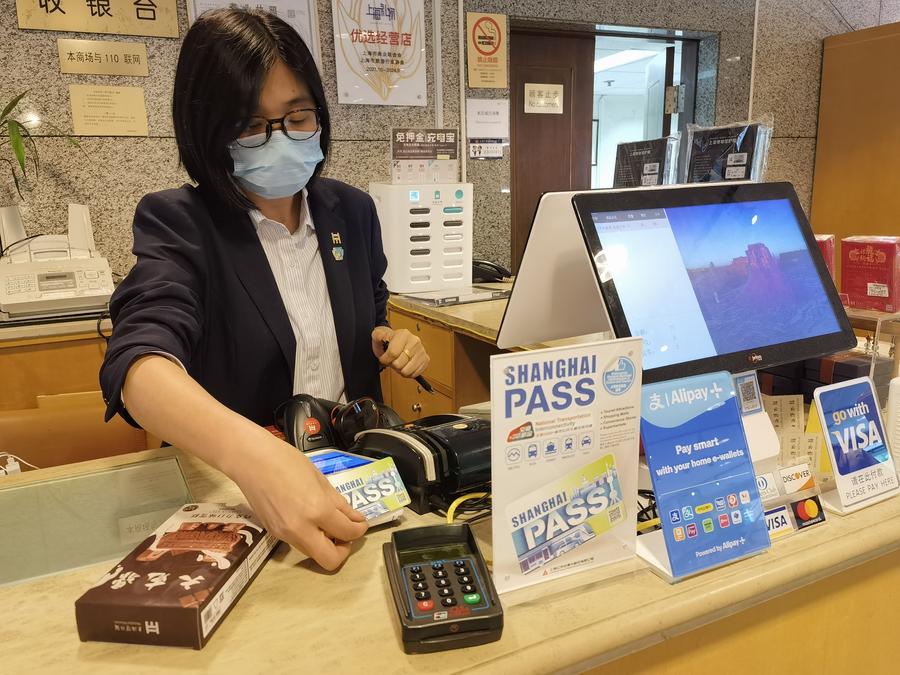
A clerk processes a payment with a shopper's Shanghai Pass multipurpose prepaid travel card at the gift shop of Shanghai Museum in East China's Shanghai on May 22, 2024. [Photo/Xinhua]
The Shanghai Municipal Government recently released a three-year action plan spanning from 2025 to 2027, outlining its vision to establish Shanghai as China's premier inbound tourism gateway and a model for integrating cultural experiences with tourism offerings.
Under the initiative, Shanghai will develop several world-class tourism landmarks. These include the Shanghai International Resort, where Shanghai Disney Resort is located, the Shanghai Sheshan National Tourism Resort in Songjiang district, and a matrix of world-class theme parks such as Shanghai Disneyland, the upcoming Legoland Shanghai Resort and Peppa Pig World.
Moreover, the city aims to establish itself as a leading global cruise tourism port while transforming Chongming Island into a world-class ecotourism destination.
A central focus of the plan is the integration of cultural elements with tourism offerings, highlighting red tourism sites showcasing the history of the Communist Party of China, historic buildings and neighborhoods, and distinctive Shanghainese and Jiangnan cultural experiences.
"In recent years, Shanghai has undertaken extensive explorations in the realms of culture and tourism. We not only boast popular attractions and theme parks but also preserve the historical context of the city," Zhang Qi, deputy director of Shanghai Municipal Administration of Culture and Tourism, told the Shanghai Morning Post.
According to city government figures, Shanghai welcomed 4.56 million inbound foreign travelers in 2024, doubling the previous year's numbers. Shanghai's unique cultural characteristics continue to attract tourists from across China and the globe, and the city is better equipped to accommodate an influx of global visitors, Zhang added.
Efforts will be made to capitalize on visa-free policies and group visa arrangements for international visitors, enhancing inbound tourism services through improved customs clearance procedures, payment systems and tax refund facilities. The city will also develop more tourism routes combining air, rail and cruise travel options for international travelers.
Harnessing modern technology plays a crucial role in this strategy. Shanghai plans to implement artificial intelligence, metaverse and blockchain technologies to create smart tourism services, enabling visitors to explore the city through digital platforms. Smart museums, art galleries and libraries will leverage technology to enhance cultural experiences.
The plan emphasizes the development of specialized tourism products catering to various age groups and interests, such as family tours, senior citizen travel and youth-oriented experiences.
Regional cooperation is also a key component, with plans to integrate tourism development within the Yangtze River Delta region and strengthen partnerships with major domestic and international tourism destinations to enhance global tourism cooperation, particularly with countries involved in the Belt and Road Initiative.
In addition, night tourism receives special attention, with evening attractions, entertainment venues, and new performing arts business forms envisioned. The plan also includes measures to develop new themed tourism formats like sports tourism, as well as fostering popular experiences like urban markets and hiking. Shanghai aims to build a demonstration zone for the metaverse tourism industry and encourages financial support for the tourism sector.
Moreover, consumption upgrades are being promoted through deeper integration of culture, tourism, commerce, sports and exhibitions, along with introducing products like ticket and shopping combo offers. The city will also attract more international art performances to premiere in Shanghai and increase the frequency of concerts and music festivals.
Implementation of the plan will be supported by improvements in infrastructure, including transportation networks, parking facilities and multilingual signage. Special attention will be paid to creating barrier-free environments and accelerating elderly-friendly renovations.
Professional travel service, market regulation and consumer protection measures are also addressed, with plans to combat illegal tourism practices and enhance tourist safety and rights protection mechanisms.